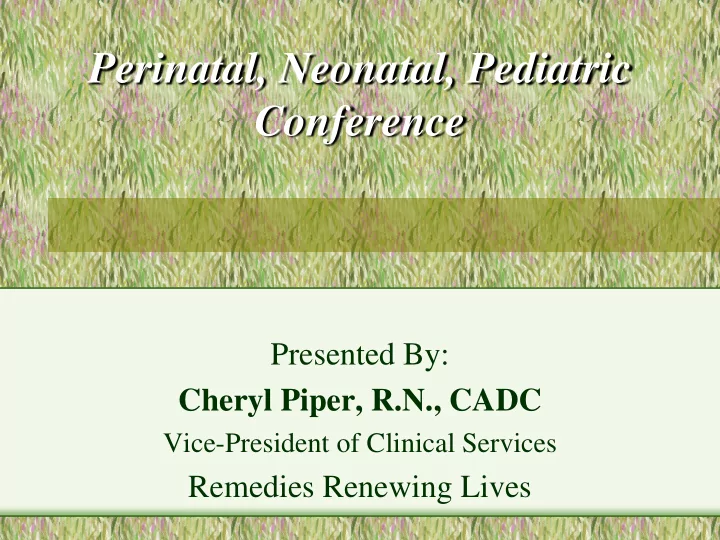

Perinatal, Neonatal, Pediatric Conference Presented By: Cheryl Piper, R.N., CADC Vice-President of Clinical Services Remedies Renewing Lives
Objectives Learn about drug trends in Illinois/Winnebago County Identify Symptoms of Substance use Disorders Recognize the impact of addiction on our Nursing practice Identify strategies to work with chemically dependent pain patients
Drug Trends in Illinois Drug arrests are above national average (828 arrests per 100,000 vs. average 620 arrests per 100,000 in other states) Alcohol and Marijuana are the most abused drugs (68%) Cocaine is making a big comeback (Up from 35% to 40%) Opiates are the fastest growing drug of abuse (48%) Hallucinogens are losing popularity (K2, Molly, Methamphetamines) Down from 18% to less than 10%
Drug Trends in Illinois (continued) • Pregnant/childbearing age female admissions to Illinois treatment facilities have increased from 32% to 46.5 % over the past five years • Approximately 3 of every 1,000 babies born in Illinois have experienced neonatal abstinence • Non-medical use of prescription opiates/heroin addiction is admitting diagnoses for 55% of treatment admissions •
Drug Trends in Illinois (continued) • Illinois rates for non-medical use of pain meds runs at 5.3 % of population (highest range is 7.2 % in Western States)
Barriers to “Treatment for Pregnant/Parenting Females • Treatment costs/availability of appropriate services. • Shame and guilt “How could I do this to my baby, my family?” “What will my caregivers think of me?” • Fearful of withdrawal • Fearful of potential loss of child (children) custody.
Barriers to Treatment for Pregnant/Parenting Females continued • Need for child care for their current children if hospitalized for treatment.
Addiction Impact on Health Care 10-15% of the general population are chemically dependent National studies indicate that between 20-40% of all acute care hospitalizations are alcohol/drug related Over 3,000 patient ED visits recorded in two of the three Rockford hospitals r/t opiate withdrawal/overdose in 2017 Rockford Fire Department reports ‘911’ calls for overdose
Addiction Impact on Health Care • Rockford Fire Department reports ‘911’ calls for overdose victims a minimum of 4 calls daily. • Winnebago County Coroner reports 124 overdose deaths in Winnebago County for 2017. Over 40% were female.
Symptoms of Addiction Early Stage • Occasional relief drinking/drug use • Urgency of first drink/use Crucial Phase • Feelings of guilt- “not normal use” • Increase in alcohol/drug tolerance •Onset of memory “blackouts” Falling out • Grandiose/aggressive behaviors • Efforts of control fail Chronic Phase • Life difficulties related to social, financial, • Decrease of alcohol/drug tolerance vocational, scholastic, legal, and health • Significant physical/psychological deterioration
Screening Tool CAGE C---------------- Have you ever tried to Cut down on your use? A---------------- Do you get Annoyed when people talk about your drinking/drug use? G---------------- Do you feel Guilty about your drinking/drug use? E---------------- Have you ever had an Eye-Opener? (Drinking or using the morning after)
Narcotic Withdrawal Symptoms Drug cravings/Anxiety Yawning, sweating, lacrimination, rhinorhea Gooseflesh, muscle twitching Insomnia, abdominal cramping, vomiting, diarrhea
Detox Protocols Clonidine 0.1 mg-0.2 mgs. every 4-6 hours for anxiety PRN Zofran PO or Tigan 200 mgs. IM or every 6 hours for nausea PRN Ibuprofen 600 mgs. every 6 hours for aching PRN Bentyl 20 mgs. every four hours for abd. Cramping PRN Buprenorphine 8/2mgs. (five day taper) MUST be in active withdrawal before administering. Methadone Taper is done very slowly (Usually 2-5 mgs. Every 5-7 days)
Treatment of the Identified Addicted Patient Explain use of opiates Validate Patient’s fear of relapse Offer support and reinforce that mediation is being utilized for a medical condition Respect Patient’s right to be involved in decision -making process and refusal of opiates Involve support system Explore alternative methods of pain management Important to remember that methadone maintenance patients will require additional pain medication beyond their daily dose
Treatment of the Unidentified Addicted Patient Monitor for Possible withdrawal symptoms Avoid mood altering drugs that do not relieve pain Identify appropriate staff as resources: Addiction and Pain Specialists, one MD for prescribing opiates, Primary Nurses to coordinate care Arrange regular staff meetings to plan care and “vent” Examine own attitudes/Do not allow a negative impact on patient care Acknowledge Limitations Pain cannot be proven Addiction treatment is not possible while patient is in “acute” pain Patient may not admit addictive disease
Establish Appropriate Goals • Monitor/medicate for withdrawal symptoms • Identify pain ratings acceptable to patient and side effects that are unacceptable • Dose until patient reports satisfactory pain relief • Avoid excessive negotiation with patient regarding pain medications
Reduce Problematic Behaviors · Be specific with expectations · Be consistent with pain relief · Avoid “rescuing behaviors” · Consider “contracting” with the patient · Make a plan for withdrawal · Give information on chemical dependency treatment services
Pain Contract • Goals for Pain Management: • 1. To make me as comfortable as possible during the acute pain phase. • 2. Relieve my pain without sedation. • 3. To control my withdrawal symptoms. • Contract Terms: • 1. The nursing staff agrees to accept and respect my reports of pain as the best indicator of how much pain I am experiencing. • 2. I may receive as much analgesia as I need to relieve pain unless the dose would put me at risk for complications. • 3. I will not tamper with the PCA equipment and, if I do, the PCA will be stopped. • 4. My other medications will be given on time. • 5. The medication used to manage my pain will be reduced gradually as I progress through my recover. • I have discussed and agree with the terms of this contract.
Summary of Treatment Strategies Acknowledgement of recovering addicts fears---RELAPSE Honor patient’s involvement in pain management process Provide additional support through involvement of 12 Step Sponsor, addiction counselors and or family Remember unrelieved pain can itself be a trigger For patients not in recovery, establish realistic goals for pain management and adhere to those goals You can lay the groundwork for a trusting relationship that can facilitate drug treatment
Recommend
More recommend